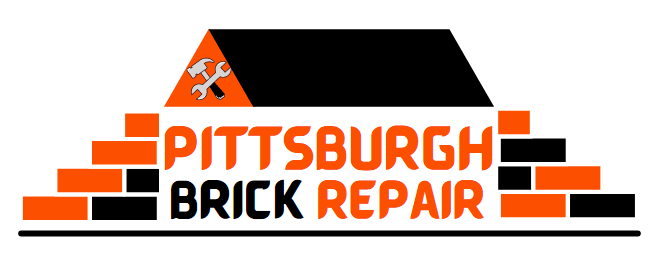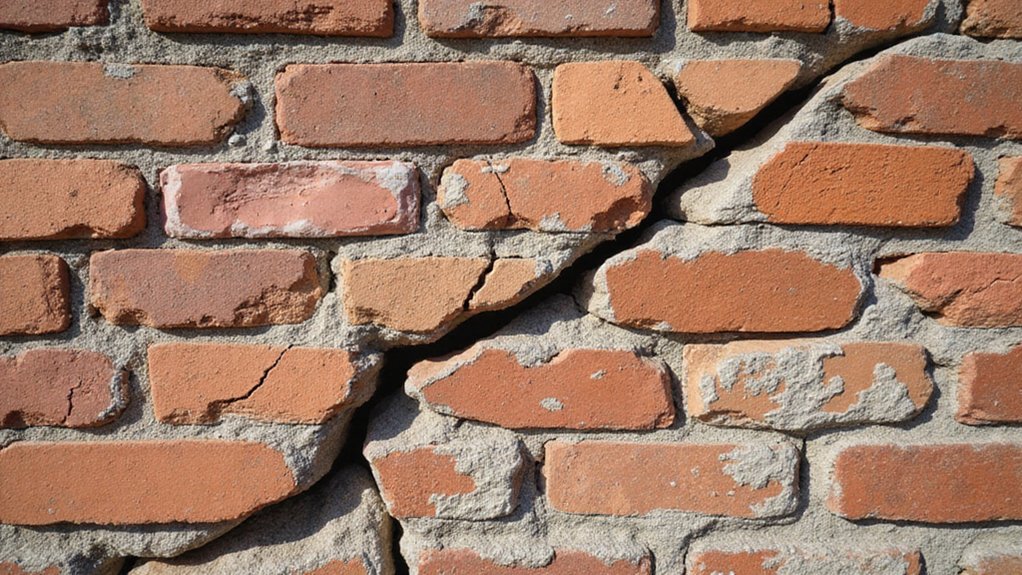Your home’s masonry tells a story, and sometimes, that story includes warning signs of structural distress. From hairline fractures snaking across walls to crumbling mortar joints, these subtle signals can quickly escalate into major problems if you’re not paying attention. Ignoring these indicators could mean costly repairs down the line—or worse, compromising your home’s structural integrity. Want to know what red flags should trigger your concern?
Vertical and Horizontal Cracks in Walls
When you notice cracks developing in your home’s walls, it’s imperative to understand their potential significance. Vertical and horizontal cracks can signal serious structural issues that shouldn’t be ignored. Moisture damage from gaps can diminish the structural integrity of walls, potentially causing extensive and costly repairs if left unaddressed. These uneven surface textures might indicate foundation problems, settling, or water damage. If you’re seeing missing mortar pieces alongside these cracks, it’s a clear sign your masonry needs professional evaluation. Don’t panic, but do take action. Hairline cracks might seem minor, yet they can quickly worsen, potentially compromising your home’s integrity and safety.
Mortar Deterioration and Joint Damage
Over time, mortar joints in masonry structures can suffer significant deterioration that threatens your home’s structural stability. You’ll notice discoloration patterns and crumbling joints that signal potential damage. Tuckpointing services can help address these critical issues before they escalate into more serious structural problems.
When mortar starts to erode, it weakens the entire wall’s structural integrity, leaving your home vulnerable to more serious problems. Cracked or missing mortar allows moisture to seep into walls, which can cause further deterioration and compromise your building’s strength.
Don’t ignore these warning signs – professional intervention can prevent costly repairs and protect your home’s foundation from extensive damage.
Bulging or Bowing Brick Walls
If you’ve noticed your brick walls starting to bulge or bow outward, it’s a serious structural warning that demands immediate professional assessment. Uneven wall surfaces indicate potential underlying issues that can compromise your home’s stability.
These structural instability signs shouldn’t be ignored, as they might signal foundation problems, water damage, or significant structural stress. Bowing walls often result from soil pressure, poor drainage, or compromised structural integrity.
Don’t wait until the problem worsens—contact a masonry professional who can diagnose the root cause and recommend appropriate repairs to protect your home’s structural health.
Water Infiltration and Moisture Issues
While bowing walls signal serious structural concerns, water-related damage presents another critical challenge for masonry integrity. When damaged flashing or improper drainage allow moisture to penetrate your brick surfaces, you’re facing potential long-term problems.
Water can seep into tiny cracks, causing erosion, mold growth, and structural weakening. You’ll want to watch for discoloration, white powdery residue, or soft spots on your masonry walls. These signs indicate water is compromising your home’s protective barriers.
Don’t ignore these warnings—professional assessment can prevent costly repairs and preserve your property’s structural health.
Efflorescence and Salt Deposits
Several telltale signs of masonry distress emerge when efflorescence starts appearing on your brick or stone surfaces. These white, powdery deposits signal moisture problems that can lead to crumbling masonry if left unchecked.
You’ll notice salt-like crystals forming on walls, which indicate water is carrying dissolved minerals through your masonry and depositing them on the surface. When you spot these chalky marks, it’s a clear warning that water is penetrating your structure’s defenses.
Don’t ignore these signs—they’re your masonry’s way of crying out for professional help before serious damage occurs.
Foundation Settlement and Shifting
Because foundation settlement can silently undermine your home’s structural integrity, recognizing early warning signs becomes essential for preventing costly repairs. You might notice horizontal cracks in walls, uneven floors, or doors that stick—classic indicators of potential foundation problems.
Soil expansion and improper drainage often contribute to these issues, causing the ground beneath your home to shift and settle unevenly. When these signs appear, don’t wait. Professional assessment can help you understand the underlying causes and develop a strategic plan to stabilize your foundation, protecting your most prized possession from further damage.
Chimney Misalignment and Leaning
A leaning or misaligned chimney isn’t just an eyesore—it’s a serious structural warning that demands immediate attention. When your chimney shifts, it could signal deeper foundation problems that threaten your home’s stability.
Consider these critical signs:
- Visible tilting or separation from the roofline
- Cracked mortar joints or brick displacement
- Compromised chimney cap or damaged flue liner
A professional chimney inspection can diagnose underlying issues. They’ll assess structural soundness, recommend chimney cap replacement, and perform all-encompassing flue liner examination.
Don’t wait until minor misalignment becomes a costly repair—protect your home’s safety and your family’s comfort.
Spalling and Surface Damage
Masonry spalling represents a serious deterioration process that can compromise your home’s structural integrity and aesthetic appeal. When you notice chunks of brick or stone breaking away, or see discoloration patterns across your walls, it’s time to take action. These surface damages aren’t just cosmetic; they signal deeper structural integrity concerns that could worsen if left untreated.
Water infiltration, freeze-thaw cycles, and material degradation can accelerate spalling. Don’t wait until small cracks become major repairs. Professional masonry experts can assess the damage, recommend solutions, and help protect your home’s longevity and value.
Frequently Asked Questions
How Much Does Professional Masonry Repair Typically Cost?
You’ll find masonry repair costs range from $500 to $3,000, depending on damage complexity. Typical repair timelines span 1-3 days, ensuring your home looks fantastic and maintains structural integrity.
Can I Fix Masonry Damage Myself or Always Hire Professionals?
You can tackle minor masonry repairs, but DIY repair considerations must weigh potential masonry hazards. Complex structural issues demand professional competence to guarantee safety and prevent costly future damage.
What Causes Most Common Masonry Structural Problems in Homes?
You’ll find weathering patterns and moisture infiltration are primary culprits behind masonry damage, causing cracks, erosion, and structural weakening that can compromise your home’s integrity and aesthetic appeal.
How Often Should Homeowners Have Masonry Inspections?
You’ll want annual reviews of your home’s masonry, scheduling periodic inspections every 1-2 years to catch potential issues early and maintain your property’s structural integrity and value.
Does Homeowners Insurance Cover Masonry Repair and Restoration?
Your policy coverage varies, but most insurance won’t fully cover masonry repairs unless damage results from sudden events. You’ll likely pay insurance deductibles and handle gradual wear yourself.

